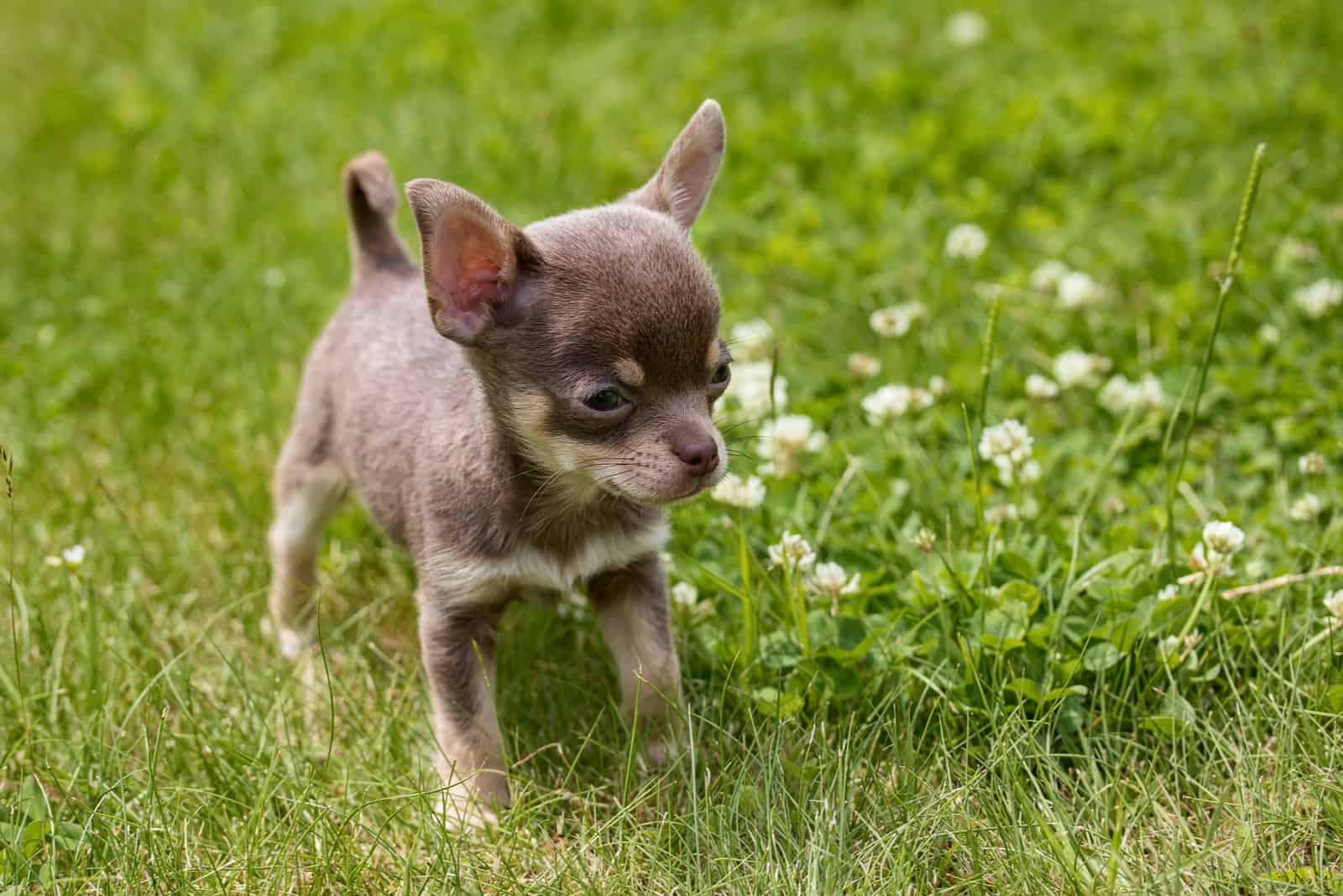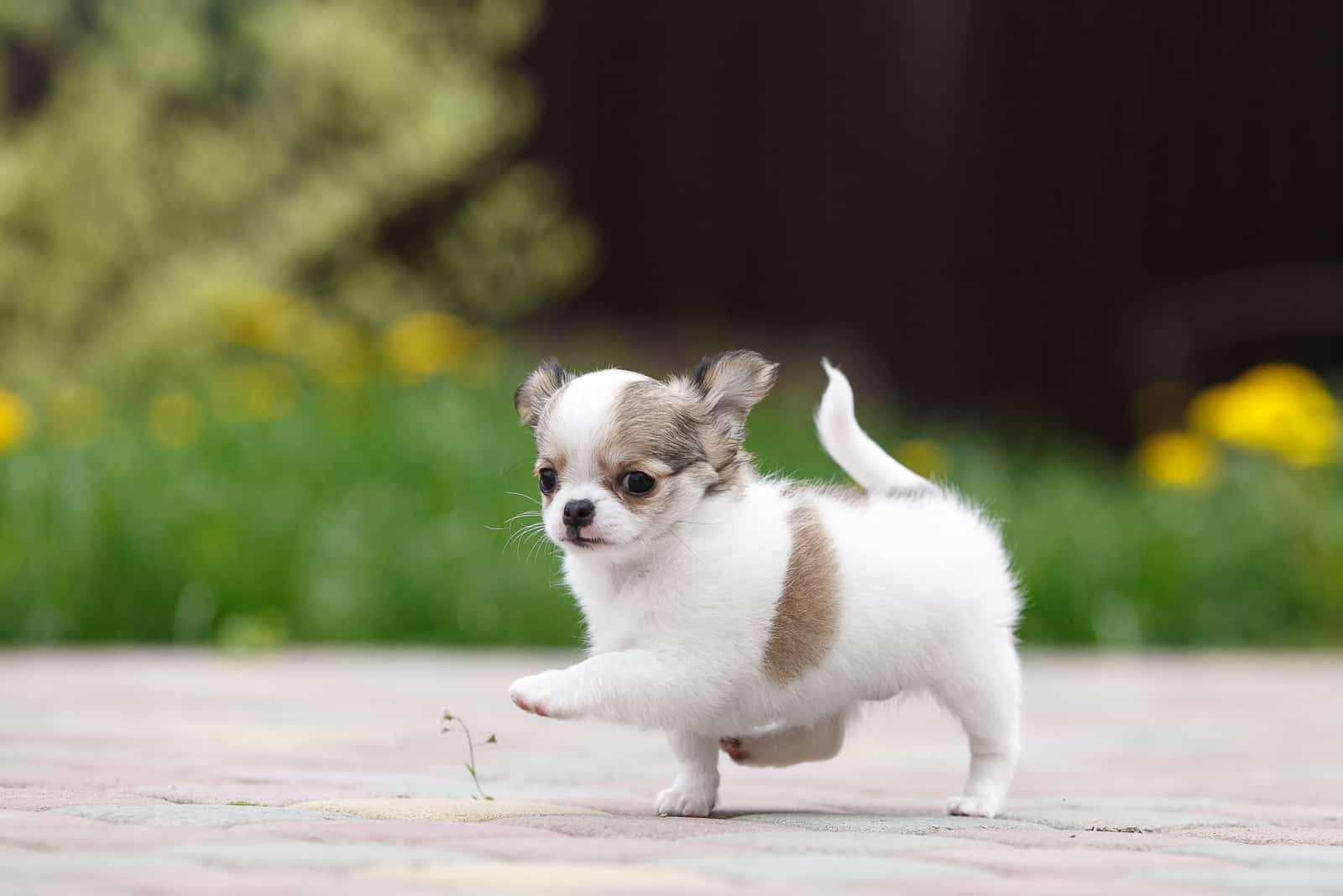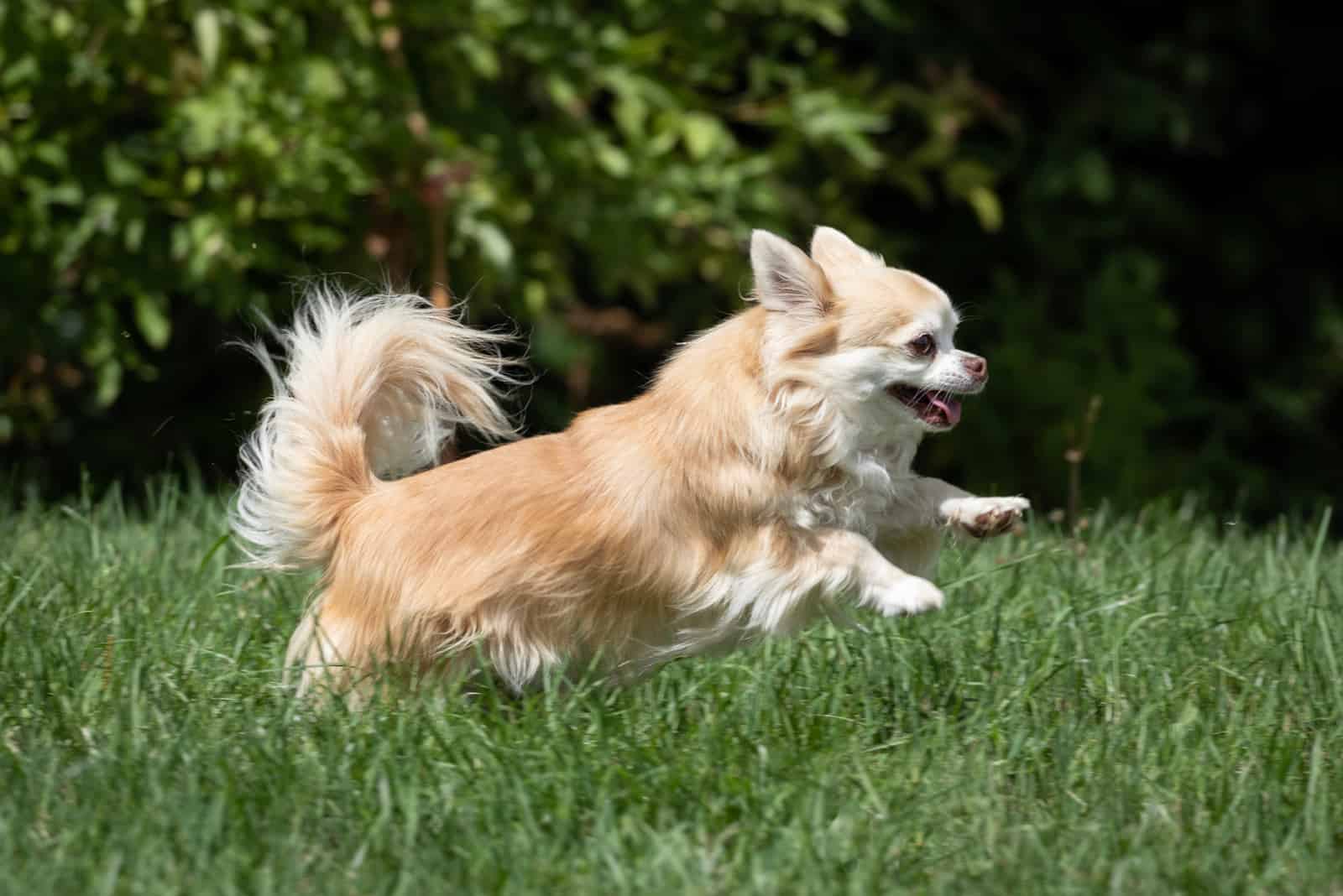Have you ever been wondering how “small” a Chihuahua can grow? Here is a Chihuahua Growth Chart to help you track the growth parameters of this petite puppy.
Often referred to as a “big dog in a tiny body”, these dynamic little fellas hold a record. They are considered the smallest dogs in the world according to the American Kennel Club.
But, that is not all. They were named after a state in Mexico. This leads us to the information of being one of the oldest dog breeds in the world.
Aside from those interesting fun facts, Chihuahuas are undeniably among the most popular dogs everywhere. There is even a song about them… “Oh, Chihuahua…”
If you decide to pursue this dog, remember to find all the relevant information you need in order to keep your pet happy and healthy.
Expect nothing less than double the fun in half the size.
Puppy Chihuahua Growth Chart

Remember that these measures are only estimates, but they can be useful guidelines or an alert if something is wrong.
This breed’s characteristic is of a petite size. That is the reason why female Chihuahuas should not be significantly smaller in relation to male dogs.
RELATED: Male Vs. Female Chihuahua: How To Choose Your Perfect Pet
Newborn Chihuahua
In the first four weeks, newborn Chihuahua puppies have the most rapid growth momentum.
Their mass at birth is a total of 2½ to 5½ ounces, with a length of three to four inches.
They are supposed to double their size at the end of the first month. Every day, they will add up to 10% of their body weight.
You should take care that these newborn Chihuahua puppies are kept warm in order to prevent freezing.
Puppy Chihuahua
The first year of a Chihuahua’s growth is a time of intense development. It is recommended to check on the puppy’s weight gain once a month.
If a Chihuahua does not grow in a month, then you probably need some advice from a professional.
During their first year, Chihuahuas will almost reach adult size.
From 3 to 11 Weeks
Their growth rate is going to be less continuous, but their progress should be seen in measures.
This is the perfect time for Chihuahua owners to start with the socialization process.
From 11 to 15 Weeks
These two weeks are, again, the time of rapid weight gain.
By the end of the third month, the current weight of a Chihuahua puppy will reach the amount of 30% of its final adult weight.
By the end of this period, the dog should get his obligatory vaccinations.
From 4 to 9 Months
This is the period when a dog is developing self awareness, and might develop separation anxiety.
At this age, the Chihuahua puppy might reach its full size. This means it will not grow taller. Further on, growth will be evident only in the dog’s weight.
This period is also the right time for dogs to start learning house rules.
It is a time of great changes for a Chi. His teeth are growing at four months, and he is reaching reproductive maturity at six months.
In this period, his activity level will reduce, and you might want to carry your puppy around. Don’t do that! Carrying Chihuahuas too much at this age can cause small dog syndrome.
From 10 to 18 Months
If your dog hasn’t reached his full size already, then he will by the end of his first year of life.
Now, he is considered an adult dog, but you will still notice some changes.
His chest will get wider in those months, he will start losing his fat, and his body shape will become leaner.
You will notice some changes in behavior. Your dog will become more aware and show more adult manners.
RELATED: Fat Chihuahua: A Guide To Slimming For Obese Chihuahuas
Chihuahua Puppy Weight Chart

There is a weight chart to easily track a Chihuahua’s growth chart. It helps you to find the dog’s current weight, and expected lifespan growth rate for each week of growth.
A dog’s weight should stay in the same column in the process of growth. If significant deviations in growth rate occur, you should probably visit a veterinarian as there is a possibility for obesity or the dog being underweight.
Tips To Manage A Weight Chart
1. Weigh your Chihuahua.
2. The first column represents your dog’s age. The next column represents your dog’s weight expressed in ounces and pounds.
3. At the end of the column, where your dog’s weight is placed, the expected adult weight is calculated.
| Birth | 2.5oz | 3oz | 3.5oz | 4oz | 4.5oz | 5oz | 5.5oz |
|---|---|---|---|---|---|---|---|
| 1 week | 3.75oz | 5oz | 5.5oz | 6.5oz | 8oz | 9oz | 9.5oz |
| 2 weeks | 5oz | 6.5oz | 7oz | 9oz | 11oz | 12.5oz | 13.5oz |
| 3 weeks | 6oz | 8oz | 9oz | 11oz | 14oz | 16oz | 17.5oz |
| 4 weeks | 7oz | 9.5oz | 11oz | 13oz | 17oz | 19.5oz | 21oz |
| 5 weeks | 8oz | 11oz | 13oz | 15oz | 19.5oz | 22oz | 24oz |
| 6 weeks | 9oz | 12.5oz | 15oz | 17.5oz | 22oz | 24oz | 27oz |
| 7 weeks | 10oz | 14.5oz | 17oz | 19.5oz | 24.5oz | 27oz | 30oz |
| 8 weeks | 11oz | 16oz | 19oz | 21.5oz | 27oz | 29oz | 33oz |
| 9 weeks | 12oz | 17.5oz | 20oz | 23oz | 29oz | 32oz | 35oz |
| 10 weeks | 13oz | 19oz | 22oz | 25oz | 31oz | 34oz | 38oz |
| 11 weeks | 14oz | 21oz | 24oz | 27oz | 34oz | 37oz | 42oz |
| 12 weeks | 15oz | 22oz | 26oz | 30oz | 37oz | 41oz | 45oz |
| 13 weeks | 16oz | 24oz | 28oz | 32oz | 40oz | 44oz | 49oz |
| 14 weeks | 17oz | 26oz | 30oz | 34oz | 43oz | 47oz | 52oz |
| 15 weeks | 19oz | 28oz | 32oz | 37oz | 46oz | 51oz | 56oz |
| 16 weeks | 20oz | 30oz | 34oz | 39oz | 49oz | 54oz | 59oz |
| 17 weeks | 21oz | 31oz | 36oz | 41oz | 51oz | 57oz | 62oz |
| 18 weeks | 22oz | 33oz | 37oz | 43oz | 54oz | 60oz | 65oz |
| 19 weeks | 23oz | 34oz | 39oz | 44oz | 56oz | 62oz | 67oz |
| 20 weeks | 24oz | 35oz | 41oz | 46oz | 58oz | 64oz | 70oz |
| 21 weeks | 25oz | 31oz | 36oz | 42oz | 48oz | 54oz | 60oz |
| 22 weeks | 25oz | 32oz | 37oz | 43oz | 49oz | 56oz | 62oz |
| 23 weeks | 26oz | 33oz | 38oz | 44oz | 50oz | 57oz | 64oz |
| 24 weeks | 26oz | 33oz | 39oz | 45oz | 51oz | 58oz | 65oz |
| 25 weeks | 27oz | 34oz | 40oz | 46oz | 52oz | 59oz | 66oz |
| 26 weeks | 27oz | 34oz | 40oz | 47oz | 53oz | 60oz | 67oz |
| Adult | 2lbs | 3lbs | 3.5lbs | 4lbs | 5lbs | 5.5lbs | 6lbs |
Adult Chihuahua Growth Chart

From now on, the body condition of a Chihuahua will no longer depend dominantly on biological factors. A great effect will be due to physical activity, and the quality of puppy food, which is the predisposition of proper nutrition and of possible health issues.
The average size of an adult Chihuahua is six inches. The estimated weight of an adult Chihuahua is between two and seven pounds.
Remember to provide your dog with an opportunity for a lot of exercise in order to avoid obesity problems.
Adult Chihuahua Size Chart
Even though it is less likely for a Chihuahua to develop obesity, it is not impossible.
Adult Chihuahuas should have a rounded body shape, but be lean and slim at the same time.
Ribs should not be seen, but you need to feel them under the Chihuahua’s skin.
Factors of a Chihuahua’s Growth

Genetics
“I got it from my mother.” Genetics are probably the most significant factor in Chihuahua growth charts.
Genes that a Chihuahua inherits from its parents will determine its growth rate and final size.
Considering its parents’ traits, it is possible to predict the size of their descendants.
Important factors are the present genetic structure and effect accomplished when these genes are combined.
Health
Chihuahuas generally have good health, with only a few health problems.
There are some parasitic diseases that can stop growth by stopping nutrient absorption.
This kind of harm can be caused by hookworms, whipworms, and roundworms.
It is not rare to detect low blood sugar in this breed, which occurs because of the small size of Chihuahuas.
Hormones
If there is a disruption in growth hormones, it will affect the growth rate of a Chihuahua.
Nutrition
When a Chihuahua is still a baby puppy, it gets all the needed nutrients from mothers milk.
If mother’s milk is not available, then you should provide supplementation that is rich with all the necessary vitamins and minerals such as fatty acids, phosphorus, sugar, calcium, amino acids, proteins, vitamin C, and others.
Further growth rate is going to depend on the quality of dog food, and a well-balanced diet.
These dogs should be fed at least three times a day, with the amount adapted to the size of the dog.
You should avoid giving human food.
Due to the fact that these dogs are very active and energized, they should be provided with enough nutritious food to maintain their energy. Besides proper dog food, you can try small pieces of meat.
Physical Activity
Physical activity is necessary for a Chihuahua to maintain muscle mass and strengthen bones. These structures are the basis of the Chihuahua growth chart.
You should also be careful with exercise. Even though it is essential for a healthy development, too much can do harm.
Chihuahuas have fragile bone structures called growth plates. If those bones get fractured, they can stop growing or coalesce the wrong way.
FAQs

When Will My Chihuahua Stop Growing?
Chihuahuas grow continuously, and they reach their full weight by the end of the 5th month, on average.
There are some exceptions where dogs reach adult size by the end of their first year of life.
After this period, your puppy will not grow significantly. There is a possibility of gaining a little more weight further on.
How Do I Take Weight Measures Of My Chihuahua?
The most practical way is to check the weight of your Chihuahua with a kitchen scale.
If you do not have a kitchen scale, you can use your regular bathroom scale.
One way to take measures is to hold your dog and measure the weight of both of you in total. Then, you measure your weight alone. You will find out your Chihuahua’s weight by deducting your weight from the total weight of you and your Chihuahua together.
While doing all this, you should take care of the puppy’s mother, who can show protective behavior towards her youngling.
At What Age Will My Chihuahua Be Fully Grown?
Chihuahuas reach full growth in size from their 6th to their 9th month of life.
Their height is five to eight inches around six months of age.
It is not a surprise that Chihuahuas reach full growth this early. Many small breeds, such as the Yorkie and the Daschund, have this characteristic.
What Do I Do If My Chihuahua’s Weight Varies From The Average?
It is recommended to track a Chihuahua growth chart in order to keep up with all the changes that may occur.
It is not likely that your dog will gain weight that is above average, or become obese. But, if you notice this kind of deviation, you should probably do a checkup.
It might be a health problem; for example, some issue connected with internal organs or hormones. Or, your dog might be taking in much more calories than he is burning through physical activity.
It may happen that your dog is above the average weight. The reason for that could also be a health problem, like some sort of parasite that is preventing the intake of nutrients. Or, your dog might not consume enough nutritive food needed.
How Big Will My Chihuahua Grow?
The average size of an adult Chihuahua is six inches in height, and three to six pounds of weight.
There are always deviations from the standard. Some adult Chihuahuas can be smaller than average while others can be significantly larger.
A Chihuahua growth chart is a useful tool for approximately predicting its final size.
There are several factors that can impact growth development.
Biological factors, such as genetics, determine growth rate through a combination of two sets of parental genes. So, a simple look at the parent’s size can be an indicator of what size to expect.
Another interesting indicator is the size of the Chihuahua’s paws. When the paws are significantly bigger than the rest of the body, then you can expect a higher growth rate.
Also, there is a possibility of a DNA test, which can help predict growth more accurately.
Will neutering have an effect on my Chihuahua’s growth?
This process should not have an effect on a dog’s growth.
Some behavioral problems may occur regarding the sudden hormonal change.
If this is the case, you should talk to your veterinarian.
Why Is It Good To Know How Much A Chihuahua Will Grow?
When we are able to predict possible outcomes, then we are able to prepare for possible difficulties.
By having all this useful information, you can identify and prepare food and water supplies. Also, you can recognize harmful changes or injuries. Organize time for exercise and play, and prepare all needed accessories
To Wrap It Up
The Chihuahua growth chart has proved itself to be a useful tool for tracking the growth progress of your little dynamic pet.
Chihuahuas are among those cult dogs because of their character and attitude.
On AKC lists, these cuties are among the most popular purebred dogs. Chihuahua breeders can accentuate several Chihuahua types including the Deer Head Chihuahua, the Teacup Chihuahua, the Apple Head Chihuahua, and a few more.
Because they are so tiny and fragile, you need to pay extra attention to maintaining their health and happiness. In return, they will offer you their joyful presence and a lot of fun in small measure.
What is your favorite small-sized breed? Let us know!













